~ The Study of Threes ~
http://threesology.org
Like several home pages before, let me begin by offering a few links:
Here are three links for Dr. Dundez's article "The Number Three in the American Culture" which appeared in an old 1967-1968 book entitled "Every Man His Way" (which is a collection of different Cultural Anthropology readings): |
As the title states, this page is intended for Threes Researchers. If you are unfamiliar with "threes" as a research project, the information may or may not be of interest to those who have not themselves ever noticed a frequency of patterns-of-three in different subject areas (other than the typical attention given to specific culturally-related examples such as death (or calamity) occurs in threes, people waking up some time between 3 and 4 AM (claimed by some as a spiritual awakening), or hearing three knocks, or expressions such a three times the charm, threes in fairytales, the Trinity (in and out of Christianity), etc....
While the contents regarding the specific issue related to a collation of threes examples could well be presented in a more expansive outline, I can give but a smidgeon of examples so as not to make a single web page too bulky. The impetus for this page comes from a short e-mail exchange with Simon Kelsey, a threes colleague living on the African continent whose knowledge and interest in the Threes Phenomena is as sincere as it is serious... albeit not lacking in humor. It began simple enough. I sent him a link and image regarding a site which described the burial of three individuals which is accompanied by commentary regarding the supposed interpretation of what the positions of the three long-dead bodies represented:
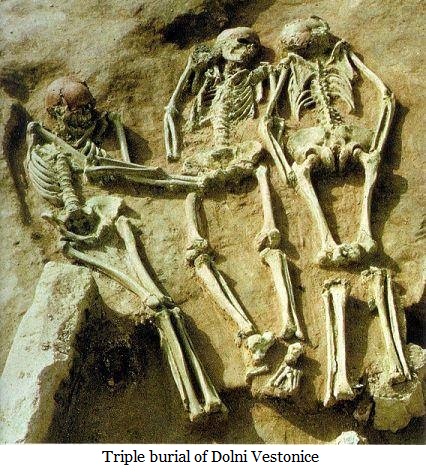
Dolni Vestonice and Pavlov burials, including the triple burial
After a short review of the information, I was rather amused because it was clear that the positions offered other explanations... that is if one wanted to engage in speculation. My message to Simon was: "It seems those who are attempting to analyze the positions of the three have never seen the various positions which can occur by placing or dragging or tossing someone into a grave. I wonder what they would read into the positions of those multiple bodies that were buried by the Nazis... if they had no knowledge of the Nazis? It seems to me the people making the interpretations are reading things into the positions which may have occurred by accident".
Simon's response was: "More seriously, this is why I think that in order to "qualify", threes should not be random. Stated more positively, threes should have a "family connection" & unity, or as I put it, a three yet oneness ... hence my term triunes.
My return reply was:
The idea of a "family" connection is perhaps somewhat timely since I am presently working on my family tree at Ancestry.com. (Involving "relationships".)
As for the family connection, this is an observation which we have no doubt applied to "threes" ideas, whether consciously or otherwise. However, we must then add another category for those threes which are associated together by what may at first be labeled as an arbitrary connection dependent on the user (Such as friends, neighbors, colleagues, acquaintances, etc...). In addition, we may want to think in terms of a third category for close ties such as we analogously find among relatives... such as close cousins, aunts, uncles, nieces, nephews, grandparents, grand-uncles, etc...
It's as if we are either dealing with a mathematics equation where there are groupings of variables and stand-alone figures, as well as binary forms... and/or we are symbolically involved with some sore of chess game where different pieces work together in groups (where some are sacrificed) along paths involving the three directions (vertical, horizontal, diagonal).
Here is Simon's interesting and thought provoking follow-up:
To your point: The diversity of possible relationships between members of triunes, as well [in a further multitude of ways] with other triunes hints at a subtlety & richness that is belied by the seeming simplicity of the basic three-yet-one theme or pattern.
I think that the dualities, other patterns & degrees of relationship that you suggest may [ultimately] also be subsumed by the fundamental triune pattern— here I reference [from genetics] the idea of expression i.e. what is dominant & what is recessive. More generally, chaos theory & cellular automata explore how complexity arise from simplicity. At an intuitive level this is appealing, because one senses that behind the apparent complexity of the phenomenal world we perceive lies an essential unified simplicity... literally our uni-verse. And this is the task of all seekers [regardless of the modality of their enquiry] to discern &mash; make sense of life or... having already discerned [as we think we do] the simple, unified & essential triune nature of reality, to then work outwards towards the apparently "messy" real world which [on the face of it, if not actually] seems to violate the "sacred" triune pattern we so lovingly regard. Put another way, it’s evidences our growth & maturity as "triophiles"...
While the question of what constitutes a "viable threes representation" may not have crossed the reader's mind... or if so, only as a brief digression with no follow-up soliloquy that manifests itself into a written description; it is of need that I do so in order that it is a topic that has not been overlooked as more and more threes examples are tabulated into a singular compilation interspersed with variable lists defined by the context in which one may have found an example.
At this juncture, let me provide a "three" example in the form of being labeled a "Trinity" out of a typical religious context meant to be applied to a religious context with idenfying similarites:
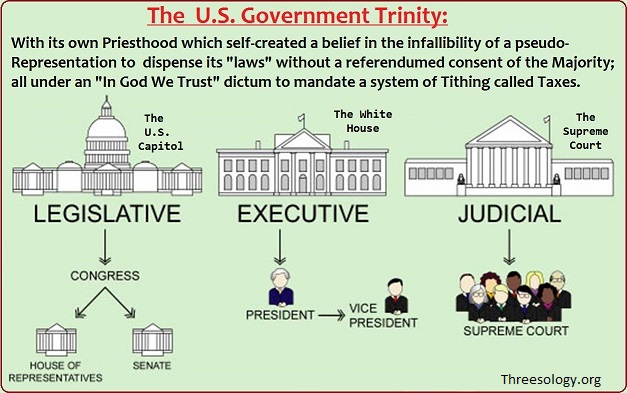
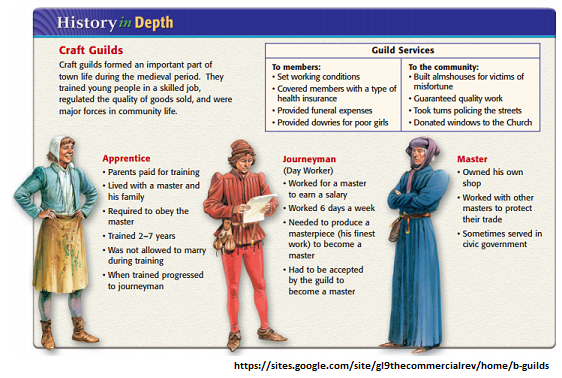
While the correlation between the U.S. government and the Christian religion is not typical, the represented connections can be easily understood once the connections are permitted from the vantage point of an enlarged perspective. However, the correlations being made in the next two representations clearly require a more detailed knowledge of the separate contexts, and for those who are unaware of it, the LGBTQ (Lost Boys and Girls Totemic Quorum) is a present day practice of ancient fertility worship themes. Hence, the comparison between the old idea of a poltico-social guild system and a present day variation of ancient relgious-oriented fertility cult practices is but another example of comparing social politics/government with religious ideology. Since many readers are no doubt aware that many seemingly non-religious social activites have some connection to, with, or because of religion, the trifunctionality expressed in Georges Dumezils' Tripartite Ideology of Indo-Europeans comes to light and can be contrasted with supposed non-tripartite organized cultures in different (non-European) times and places.
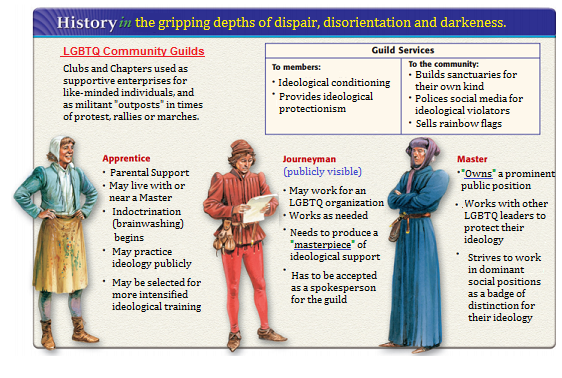
Let us take a brief look at an example of "relatedness" in terms of marriage, while noting the same ideas about inter-marrying of particular cousins may not hold true for all cultures, just as some threes examples may not hold the same value from one subject to another, or from one person to another. While a degree of importance for a given example, given subject within an example, or collection of examples may not be shared (agreed to) amongst all threes researchers, such distinctions may be more than just personal preferances or semantic quibbling in some cases.
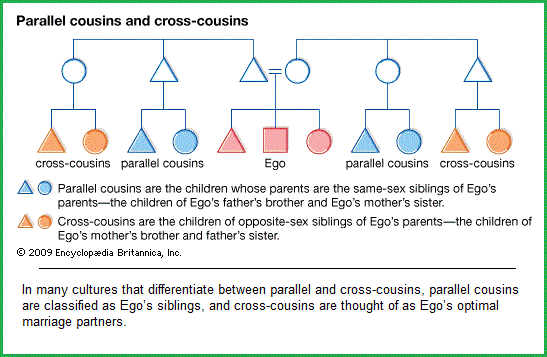 |
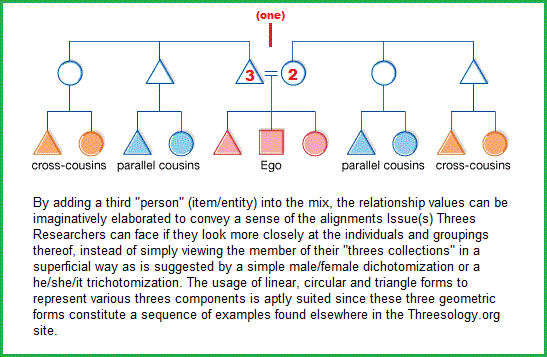 |
For example, do we claim that a "three" in the form of children who are "exact" triplets has a closer "three" relationship that say three siblings who are not triplets... neither maternal nor paternal? No less, is the arrangement of items in an example made more valuable or important in one or all settings? While to the generalist who is only interested in collecting as many examples of "threes" (or whatever pattern) they can without questioning the validity thereof... since if it is written down or expressed in any way... this alone qualifies the example as being real and right; those who seek a more detailed explanation to be used in an eventual textbook or encyclopedic form, may want their list(s) to cover those questions which a student of this particular research genre may come to ask or at least wonder about.
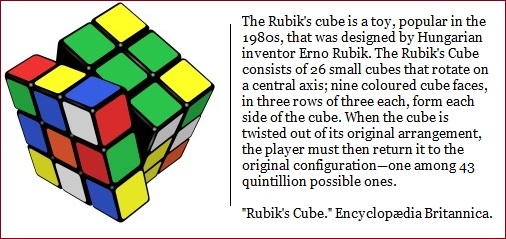
Is the arrangement of neutron-proton-electron, for example, a different "three" than proton-electron-neutron or electron-neutron proton? Or are we simply satisfied that they can all be lumped under a heading entitled particle physics? And though the reader may want to suggest that such a question is quibbling over semantics, what if the different threes examples each represent a numerical (or other symbolic value) that must be in the right order like the squares of a Rubik's cube whose socially accepted "answer" is to have all the colors of all the sides matched? Are there sub-surface "properties" or infinitesimals which create a different "threes" product like a recipe whose ingredients MUST occur in a given order or arrangement (and not merely due to personal preference)? For example, while some people prefer to have eggs for breakfast, others will eat eggs any time of the day. And while some like to take a shower in the morning, others prefer to take one at night, while still others take showers at "odd" (instead of "even"?) times. No less, the different choices routinely occur at one time or another, and these times are frequently denoted as morning, noon and night. Hence, the order one "prefers" may be a preference due to some life-style or occupational training which gives the timeliness a type of preponderance of meaning to occur when it does. The ordering, though we may say it is a preference, may be learned and accommodated to, instead of an activity being made to accommodate one's presumed preference.
How to arrange examples of threes and what constitutes a three according to a given criteria, is a puzzle threes researches must invariably wrestle with. Whether involved in figuring out syllogisms (I call them silly-gisms), playing poker with three face cards, trying to find a marble (etc.) under three shells or cups, or what constitutes a religious trinity (outside the definition used in Christianity)... etc., may well tax the patience of some who view the problem below either as a no-brainer or something unsolvable:

If we are categorizing examples of threes in the same way again and again, why is this... unless we are actually carrying out so-called "research" in threes by a method of rote application that we are not consciously aware of? Our preferences for our collections may reside in a given subject area, and all other areas are given a generalized superficiality. While those only interested in creating a list of the most threes that they can (with or without including other enumerated patterns) and do not have an interest in seeking out one or another explanation for types, variations, context, application, origin, etc..., others may find themselves in need of re-assessing their evaluations of the threes phenomena. In other words, collecting as many threes as they can, or recording how many threes they themselves use on one another day, week or other selective time period may not be enough.

Another aspect of the "relationship" amongst an external consideration of threes, is whether or not we can lump all examples of threes together and assign them with a definition of being a recurring product of the human mind. Even though biologists define us as a similar species based on simple criteria such as being able to mate and produce offspring, is this actually enough to establish a like-mindedness? If we of today were able to mate and produce offspring with an Australopithecus afarensis known affectionately in Anthropology circles as Australopithecus afarensis, does this mean the threes produced by such a "person" would be closely or distantly related to threes we of today produce... even if in the mind of the A. afarensis a "three" grouping might be a rock, a bird, and eating... and would not likely be written down nor spoken of? In other words, what we think, what we interpret to be a pattern-of-three being exhibited by behavior may not actually be a cognitive construct in such a (supposedly) distant relative's mind? While some may say yes and others no, the point being made is to bring to bear the possibility that all the threes examples one may have compiled, may or may not be examples from the same type of "normal" brain. For example, if we assume that the theory of Julian Jaynes is right about early humans, is his interpretation of the Iliad and Odyssey to be applied to all humans across the earth during the same period, or just the Greeks? Did all humans across the globe imagine the same world... in their respective environments, to suggest the entire past history of humans at a given era were what we of today would refer to as being mentally ill? Let us take a look at a short excerpt of Jaynes' idea:
"I have endeavored (in these two chapters) to examine the record of a huge time span to reveal the plausibility that man and his early civilizations had a profoundly different mentality from our own, that in fact men and women were not conscious as are we, were not responsible for their actions, and therefore cannot be given the credit or blame for anything that was done over these vast millennia of time; that instead each person had a part of his nervous system which was divine, by which he was ordered about like any slave, a voice or voices which indeed were what we call volition and empowered what they commanded and were related to the hallucinated voices of others in a carefully established hierarchy."
And if we include the notion that the early gods were ambivalent, easily angered and took out vengeance against specific individuals as well as large swaths of humanity based on feelings clearly representing human emotion, does this "ambivalence" (described as love/hate, right/wrong, good/bad... etc.,), also describe schizophrenia (which actually refers to a suite of mental illnesses and not just one type)? Whereas to this line-up of examples can be associated the ideas of duality and androgyny... both constituents of early and present day religious thought. In other words, are the threes of a mentally ill person to be considered a close or distant relationship to those threes which an (assumed) non-mentally ill person would have? For example, if we conclude that some examples of threes are those representing ideas we of today consider to be myth, fable and legends of past eras... whether or not they were actually believed to be factual by people in ancient times; do we used headings for our lists which create columns that tend to lump these examples together with ideas we of today have involving comic book, motion picture, or some fanciful religious characters for which no real evidence for their existence can be found? And in so describing, also pay witness to the presence of a modern day practice of an ancient mentality which represents mental illness?
No less, since it has been cited that the largest pool of psychopaths are in Washington D.C., are we paying witness to a present day variation of an ancient mentality whose "threes" constructs must or should be differentiated from other formulas being found not only in other subject areas, but other locations as well? And what then do we say of the rest of the Earth and its different inhabitants that may well exhibit less or more of a discernible psychopathology? Are we perhaps living amongst different species of humans despite the criteria being used by biologists to lump us all together? Why do we necessarily assume that biologists and/or anthropologists (or historians, theologians, etc...) are right in determining who is and what is to be construed as a representation of so-called "modern" human? Experts have been wrong in the past, so there is no reason not to consider they aren't wrong again and are using some romanticized (or sex-related) criteria to determine a relationship value where other criteria should instead be used by placing their notions under a heading such as superstition or a simplicity based on superficiality.
Psychopathology (also called abnormal psychology) The study of mental disorders and unusual or maladaptive behaviours. An understanding of the genesis of mental disorders is critical to mental health professionals in psychiatry, psychology, and social work. One controversial issue in psychopathology is the distinction between dysfunctional, or aberrant, and merely idiosyncratic behaviours. Source: "psychopathology." Encyclopædia Britannica Ultimate Reference Suite, 2013. |
If a particular threes researcher is not particularly bothered by the idea of distinguishing threes between normal and non-normal... or say that the idea of "normalcy" is as relative as is the definition of beauty, truth, justice, peace, etc..., then there is no further consideration need be entertained about the internal and external relationship value of threes examples. By saying that all written examples of threes belong to the family of modern humans and that despite having mental illness or not all threes constructed by such humans are to be put into the same generalized category with internalized specificity (subject area, gender, race, or other demographics), then the reader need not be unduly concerned with the content of the present discussion. Then again, for those who think that considerations involving the topic of determining whether or not we of today are actually living in the midst of different types of human "species", then our categorizations of threes (and other numerical) assignments, may need some re-evaluation since agreeing with the ideas of experts in other subject areas may be inappropriate.
At present, some threes groupings resemble the following classification scheme (including some of the listing methodologies at this site:
In other words, our lists are a hodge-podge of this, that, and another based upon a schematic we may not have actually looked closely at, because for one reason or another we have assumed that our methodology is correct... just as many readers upon seeing the above image assume that it is correct without ever considering that the methodology being employed is wrong or can be improved upon because some specificity is not being focused on by the so-called experts. For example, I have regularly cite that the so-named "triplet coding" of DNA and RNA (by various experts) can be supplemented with the realization that there also exists a 3-to-1 ratio as described the evidence that both DNA and RNA use the same three amino acids (adenosine, cysteine, guanine), but that they are respectively differentiated by the singular acids Thymine and Uracil. When we couple this to the famous 3-to-1 ratio of Mendelian genetics, and then find this same pattern in a host of other subject areas, do we call this a type of numerology because it is a superficial correlation, or that because it was not first recognized and annotated by those in a given subject area who have created a selectively enculturated discipline with a recognized hierarchy of individuals constituting a club to which I do not officially belong? Nonetheless, the point to be made is that discoveries made by so-called amateurs, is presented with a dismissiveness like the haughty arrogance found frequently amongst so-called Aristocrats in different fields of activity, be it business, religion, politics, science or otherwise.
|
Mendelian inheritance is usually described as the process by which one of two alternate alleles of a gene is inherited from each parent so that the offspring has one of the following combinations: two dominant alleles, two recessive alleles, or one of each. If both parents are heterozygous, that is, have one of each allele, the three genotypes will occur among the offspring with the following probabilities:
Phenotypically the two heterozygotes will be indistinguishable from the homozygous dominant. This results in the
famous 3:1 ratio James C. King, The Biology of Race, 1981, page 28) |
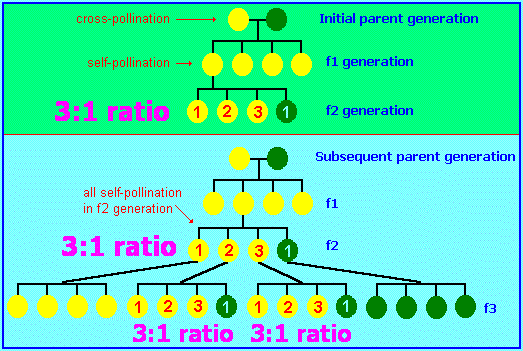
Source: Let's Talk Peace page 14
In other words, with the above example in mind, how do we classify the presence of a "three" pattern that exists with a 3-to-1 ratio along with the pairing of amino acids, that we may or may not want to include the three "stop codons with one start codon" evidence as part of the assemblage? Do we preferentially pick and choose to serve some personalized criteria that does not take in all the relevant data at one's disposal, or do we go back to the drawing board (as I have done several times) upon finding different ways in which material may be correlated due to known and recently found patterns? Is the route we take disposed to assist some recognized or sub-conscious idea/ideology our brain is masticating over... but because such mastication is a taken-for-granted daily exercise, we overlook its influence to guide or distract us?
Whereas an early catalog of threes may have been based on superficial accountabilities, we find ourselves expanding our horizons (such as taken a step back in order to adopt a longer, larger and more in depth view) as we become more comfortable with accepting the realization of our perceptions. Perceptions that for the novice may at first make them react disbelievingly at the amount and type of threes patterns which they uncover (not to mention twos, fours, fives, etc... and the existence of an overlooked cognitive limitation in this regard). And though many people may have come to pay witness to such a recurrence, they do not (for whatever reason), reach a point that they begin to make a personal catalog of their perceptions... much less any contemplation they may have about the subject. Most people obviously do not write down their perceptions which become mentally catalogued into a list. Some people instead keep such patterns of perception to themselves by making a mental note to be used as information for personal interests in one setting or another, such as a catalogue of human behavior that they can use to benefit themselves with. In other words, they interpret such patterns as personal secrets to be used to maneuver themselves or another into a position that may provide them with an opportunity of say... employment (which may be at the expense of another who is just as qualified but are not privy to a bit of patterned information applicable to a given time and place). Such a pattern may be the presumed step-wise "relevance" of information displayed in a certain way on a job application... which involves the admission of accessible documentation such as certification, education, former employment reviews, etc...
Whereas some researchers may come to make a realization for the existence of additional patterns with or next to a "three" pattern we have customarily taken-for-granted or have accepted so-called expert testimony that a given pattern is most important and that any other nearby pattern... three or otherwise, is a negligible addition; there are instances where a three can be overlooked because a non-three pattern is being used as a predominant theme of expression. For example, when people cite the "LGBTQ" monogram, they do not customarily recognize the presence of an underlying three pattern, and that although it is herein being denoted, one should not think it is the only pattern one might devise based on other criteria:
- (L and G): Lesbian and Gay refer to separate, singular genders.
- (B and T): Bisexual and Transgender refer to dualistic or androgynous doubles.
- (Q): The "Q" references multiplicity in the words queer and questioning.
Hence, the supposed "five" of this lineup can be viewed as a "three", thereby denoting an underlying cognitive reference similarly found in other subject areas. And while some readers may want to think that my usage of this example is a means for me to suggest a "coming out", let me state for the record that I think the "LGBTQ community" is little more than a present day variation of antiquated fertility cults commensurate with ancient practices of phallic worship. However, it should be further noted that ancient humans did not see anything obscene with displays of the penis or vagina noted as Lingam and Yoni in past fertility rite practices. The ancient fertility rites were focused on ideas related to generative properties involving not only more humans, but more of many other things such as needed rain, needed sunshine, needed crops, etc... Such practices were not focused on expressing psycho-pathological or socio-pathological perversions of sexual activity as are some members of the LGBTQ fertility cult, whose "generative" interests are hedonistically related to personal orgasms with people, animals or objects. Whereas members of the cult believe they are promoting an expression of freedom that everyone should embrace and thus feel they have acquired another dimension in their equal rights and overall in their Inalienable Rights, they are actually representing little more than an opportunity for students of psychology, sociology and anthropology to experience what a mindset of the irrational past was like in its heyday. For example, take a look at a short and superficial list of some of their accepted "orientations":

The short list does not provide an accurate and honest perspective of the practiced perversions nor give an adequate explanation why so-calling loving and compassionate adults needs to practice a yearly "Pride" exhibitionism in which alcohol is used as a means of inebriating the public into an acceptance of the group's presumed normalcy instead of its nauseating insecurity and multi-colored blanket which acts as a pacifier, also known as a binky and blanky (used by those attempting to assuage self-absorbed feelings in a child that may be scared, pouting, or otherwise as ego-centric as Narcissus... because the world must revolve them or something is wrong with the world but not themselves).
If any reader would care to take the above list information and "three-a-size" it under some serious or museful criteria, I would be happy to review it. Perhaps one might use the criteria of recognizing that the "L" in the (LGBTQ) monogram also suggests a female-led organization akin to a present day variation of a matriarchal society that has been noted as a "gynæcocracy", though some members of the cult may want to argue that the placement of the letters has no "ulterior" (slip of the tongue)- motive and represents an arbitrary alignment, the above three-patterned designation which reveals the one-two-three (multiplicity) says otherwise. In other words, we have a female designation in the lead followed by a male placement that is followed by what appears to be a hierarchical arrangement of status amongst the cult... like the hierarchical line-up found in business, government, religion, sports teams, gangs, prison populations, families, etc... The Lesbian led sex-related "community" reeks of the ancient time in which simple and honest fertility rites based on generative interests in the minds of primitive peoples who did not even understand how infant children came to be produced, became adulterated into obsessive rites of perversion, as illustrated by the following excerpt about an orgy practice:
"There are then some couple together in their sacred feasts (as they term them) promiscuously, when they meet in their delubriums where they spread a clean table-cloth on the floor, on which they place their banquets to inflame their lascivious heat, which must be acknowledge to be set on fire by hell, whatever the extract that they worship as a spark of the sun, may be descended to be. When they take away, they strew the foul cloth with meal-flour, and the better to perpetuate their incestuous lusts, they put out the lights, and shifting themselves stark naked, the men and the women, the men cast their breeches on a heap in a corner of the room; which being done, the women run in the dark to catch as catch can; and whatever lot they light on, the lamps being again lighted, they firmly embrace for their lover, or any other relation: and which is still worse, the night being spent in bestiality, the nasty Flour (which by their filthiness either of vomit or excrement in which they wallowed like brutes) is kneaded into a paste, and eaten as a sacrament to repeat the same ungodly Festival annually, as if it were a sacrifice well-pleasing to their deities. [John Fryer, A new account of East India and Persia, London, 1698, p. 266]
Source: Phallic Worship (a history of sex and sexual rites), George Ryley Scott, 1966, ISBN: 1 85958 195 1
I brought up the topic of the three pattern in the LGBTQ cult because I have been reviewing what I believe to be a form of dementia in a series of pages
entitled Source: A Female Political Leadership? (page 1)
, which delves into the
consideration of the value of a presumed "greater" female psyche that had existed once and was revered to the extent that a Matriarchal society once
existed, but for various reasons became supplanted by a male psyche and that both of these (as I shall say in the continuation of the series), must be
considered in context with what Carl Jung referred to as the Collective Unconscious... but in fact may be the recognition of a shared mental illness which
manifests itself into an epiphenomenon, that I interpret to be a culprit behind the present Age of Irrationality we are living in... But that the androgyny of
the male/female "birth" of a collective unconscious can manifest itself into a consolidated singularity that can be obscured from the perception of those whose
own myopia (tunnel vision) is directed towards a spot of light without referencing the surrounding darkness as a mobile shadow. Whereas this may sound a bit
abstract, its basic pattern (now that we know it exists in other subject areas), is like that of the LGBTQ organization 1,2, many theme and is consistent with
what we can find in the number word references of primitive peoples sharing the same mentality of numerosity (abstracted into a current sex-related theme by
the LGBTQ cult). The one-two-many (or multiplicity), when combined, produces a singularity which then produces the observable criteria of a three-to-one ratio.
You wouldn't think to look for the presence of such a "creature" hiding out in the shadows of consciousness, if you were not made aware of its possible
existence... and were psychically prepared to think in such terms of analysis without resorting to some superstitious, evil, or godlike label as an explanation.
For the present, let me leave this journal etching with those who may find it of interest.
Page Originated: Wednesday, 4th July 2018... 12:40 PMInitial Posting: Thursday, 5th July 2018... 10:35 AM
Updated Posting: Thusday, 13th September 2018... 8:36 AM
